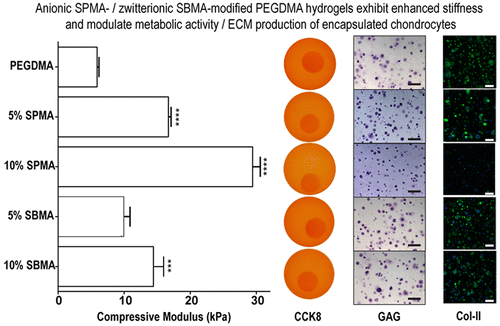当前位置:
X-MOL 学术
›
ACS Biomater. Sci. Eng.
›
论文详情
Our official English website, www.x-mol.net, welcomes your feedback! (Note: you will need to create a separate account there.)
Anionic and Zwitterionic Residues Modulate Stiffness of Photo-Cross-Linked Hydrogels and Cellular Behavior of Encapsulated Chondrocytes
ACS Biomaterials Science & Engineering ( IF 5.8 ) Pub Date : 2018-03-05 00:00:00 , DOI: 10.1021/acsbiomaterials.8b00124 Henry Huang 1 , Yu Tan 1 , David C. Ayers 1 , Jie Song 1
ACS Biomaterials Science & Engineering ( IF 5.8 ) Pub Date : 2018-03-05 00:00:00 , DOI: 10.1021/acsbiomaterials.8b00124 Henry Huang 1 , Yu Tan 1 , David C. Ayers 1 , Jie Song 1
Affiliation

|
Photo-cross-linked poly(ethylene glycol) dimethacrylate (PEGDMA) hydrogels have been widely utilized for cartilage tissue engineering. However, strategies for improving their stiffness have been predominantly limited to increasing the degree of photo-cross-linking or weight fraction of the polymer. In this study, we tested the hypothesis that covalent incorporation of anionic sulfonate or zwitterionic sulfobetaine residues into photo-cross-linked PEGDMA hydrogels could enhance their mechanical properties without altering overall polymer content or swelling behavior. In addition, we investigated whether and how covalent incorporation of these chemical residues would affect cartilage extracellular matrix secretion by encapsulated chondrocytes. With the incorporation of 5–10% anionic or zwitterionic residues, the compressive moduli of PEGDMA hydrogels increased and the stress relaxation expedited while the swelling behavior and overall polymer fraction were kept the same. The incorporation of anionic residues exerted a more profound incorporation content-dependent impact on compressive moduli than zwitterionic residues. Higher-content incorporation of the anionic residue (10% vs 5%) also reduced the metabolic activity and type II collagen secretion by encapsulated murine chondrocytes and limited the pericellular diffusion of secreted proteoglycans within the 3D hydrogel. Although encapsulated human chondrocytes exhibited different sensitivity to serum level in culture than murine chondrocytes, the general trend of the impact of covalent incorporation of the chemical residues on their ECM secretion was the same. Overall, covalent incorporation of anionic and zwitterionic residues at an appropriate content presents a viable alternative to increasing the degree of photo-cross-linking for modulating the stiffness of PEGDMA hydrogels and the metabolism and phenotypical matrix secretion by encapsulated chondrocytes. It underscores the significance of noncovalent interactions imposed by charged residues in modulating biomechanical and cellular properties in tissue engineering scaffold designs.
中文翻译:

阴离子和两性离子残基调节光交联水凝胶的刚度和包囊软骨细胞的细胞行为
光交联的聚(乙二醇)二甲基丙烯酸酯(PEGDMA)水凝胶已被广泛用于软骨组织工程。但是,改善其刚度的策略主要限于增加聚合物的光交联度或重量分数。在这项研究中,我们测试了以下假设:将阴离子磺酸盐或两性离子磺基甜菜碱残基共价掺入光交联的PEGDMA水凝胶中可以增强其机械性能,而不会改变整体聚合物含量或溶胀行为。另外,我们研究了这些化学残基是否共价结合以及如何共价结合将影响封装的软骨细胞对软骨细胞外基质的分泌。随着5-10%的阴离子或两性离子残基的结合,PEGDMA水凝胶的压缩模量增加,应力松弛加快,而溶胀行为和总聚合物分数保持不变。与两性离子残基相比,阴离子残基的掺入对压缩模量具有更深刻的掺入含量依赖性影响。更高含量的阴离子残基掺入(10%比5%)也降低了封装的鼠软骨细胞的代谢活性和II型胶原分泌,并限制了3D水凝胶中分泌的蛋白聚糖在细胞内的扩散。尽管封装的人软骨细胞对培养物中血清水平的敏感性不同于鼠软骨细胞,但化学残基共价掺入对其ECM分泌的影响的总体趋势是相同的。全面的,适当含量的阴离子和两性离子残基的共价掺入为增加光交联度提供了可行的替代方法,以调节PEGDMA水凝胶的硬度以及封装的软骨细胞的代谢和表型基质分泌。它强调了带电荷的残基在调节组织工程支架设计中的生物力学和细胞特性中所产生的非共价相互作用的重要性。
更新日期:2018-03-05
中文翻译:

阴离子和两性离子残基调节光交联水凝胶的刚度和包囊软骨细胞的细胞行为
光交联的聚(乙二醇)二甲基丙烯酸酯(PEGDMA)水凝胶已被广泛用于软骨组织工程。但是,改善其刚度的策略主要限于增加聚合物的光交联度或重量分数。在这项研究中,我们测试了以下假设:将阴离子磺酸盐或两性离子磺基甜菜碱残基共价掺入光交联的PEGDMA水凝胶中可以增强其机械性能,而不会改变整体聚合物含量或溶胀行为。另外,我们研究了这些化学残基是否共价结合以及如何共价结合将影响封装的软骨细胞对软骨细胞外基质的分泌。随着5-10%的阴离子或两性离子残基的结合,PEGDMA水凝胶的压缩模量增加,应力松弛加快,而溶胀行为和总聚合物分数保持不变。与两性离子残基相比,阴离子残基的掺入对压缩模量具有更深刻的掺入含量依赖性影响。更高含量的阴离子残基掺入(10%比5%)也降低了封装的鼠软骨细胞的代谢活性和II型胶原分泌,并限制了3D水凝胶中分泌的蛋白聚糖在细胞内的扩散。尽管封装的人软骨细胞对培养物中血清水平的敏感性不同于鼠软骨细胞,但化学残基共价掺入对其ECM分泌的影响的总体趋势是相同的。全面的,适当含量的阴离子和两性离子残基的共价掺入为增加光交联度提供了可行的替代方法,以调节PEGDMA水凝胶的硬度以及封装的软骨细胞的代谢和表型基质分泌。它强调了带电荷的残基在调节组织工程支架设计中的生物力学和细胞特性中所产生的非共价相互作用的重要性。



























 京公网安备 11010802027423号
京公网安备 11010802027423号